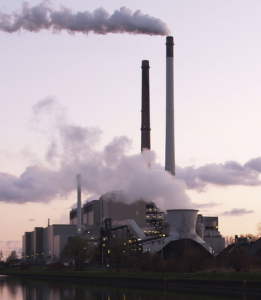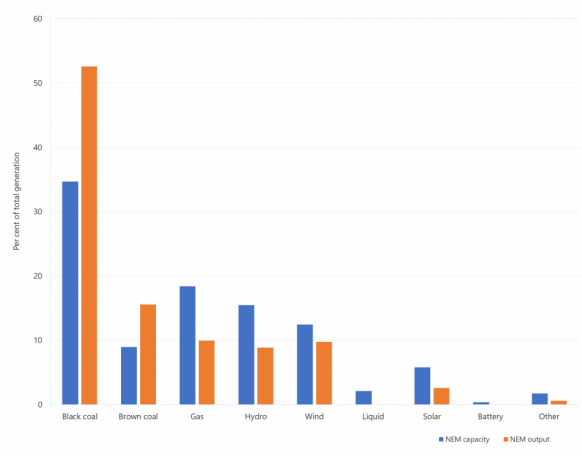Concentrated Solar Power and molten salt technology could help coal-fired generators decarbonize without closing sites, but price support will be needed, experts told New Energy Update.
While many CSP developers are seeking to directly compete with coal-fired power generation, a small group of players see opportunities in working with coal plant operators.

CSP storage technology can share coal plant infrastructure, helping operators reduce emissions. (Image credit: Arnold Paul)
Many governments have sidelined growing climate change concerns and supported coal-fired generation, either for financial or political reasons.
The integration of CSP with molten salt Thermal Energy Storage (TES) at existing coal plants offers a way of reducing coal use while maintaining dispatchable power capabilities.
Integrated solar coal (ISCoal) plants can help coal generators meet emissions standards and lower fuel costs. Project design and installation can synergize shared power plant infrastructure.
A leading CSP technology supplier, Abengoa sees deployment opportunities at coal sites for CSP-storage and storage-only solutions.
ISCoal projects can help prolong the lifespan of coal-fired facilities, Miguel Mendez Trigo, Director of Solar Technology at Abengoa, told New Energy Update.
By matching the design to the market need, molten salt storage «can give a new life to fossil-fuelled power plants which, otherwise, would be definitely dismantled,» Mendez said.
Beyond coal
Abengoa is currently working with other stakeholders on a development pathway for ISCoal plants in Australia, where support for domestic coal mining and coal power plants remains strong.
Coal plants supply as much as 75% of Australia’s electricity but many plants are ageing and intermittent wind and PV capacity will rise in the coming years.
Some regions urgently require new power capacity. In recent years, South Australia has experienced summer blackouts due to ramping air-conditioning demand and power supply shortages.
Abengoa aims to show ISCoal projects can help coal-fired generators remain competitive as renewable energy capacity grows, Mendez said.
Australian generation capacity, output by fuel source in 2019

NEM=National Electricity Market
Source: Australian Energy Regulator (AER) , January
ISCoal adaptations could allow Australia to perform a softer transition towards decarbonization goals and help preserve coal-centric communities, George Brakmann, Managing Director at engineering consultancy SolEngCo, told New Energy Update. Based in Germany, SolEngCo has worked with utilities on ISCoal plans.
«Converted coal to storage plants have the social advantage of securing jobs and investments at the existing site locations,” Brakmann noted.
Market-focused
One operating model for ISCoal is to use CSP to charge TES during the day while the operator uses cost-competitive PV or wind, and dispatch the stored power during evening peak demand periods or overnight.
This provides a flexible plant that can adapt generation profiles to actual energy demand and reduce operating costs, Mendez said.
In some markets, such as those with lower direct normal irradiance (DNI) levels, the most cost-effective design is to instead use electricity from the grid to charge a TES system, Mendez said.
“Using electricity to heat thermal storage may not be as ideal in engineering terms, but it’s actually able to provide the most win-win solution to a market need,” he said.
According to Abengoa, this solution could be attractive in any coal-dependent power market.
Germany could be a viable market for such projects, due to a long legacy of coal-fired generation sourced from domestic mines.
«We have approached all German operators of coal-fired power plants and informed them of the benefits,» Brakmann said.
Proven concept
In 2010, Abengoa completed the world’s first ISCoal plant at Xcel’s Energy’s Cameo Generating Station in Colorado, USA.
The $4.5 million project was supported under Colorado’s Innovative Clean Technology Program. The CSP system consisted of eight 150-meter rows of parabolic trough technology, attached to one of the Cameo plant’s two 49-MW coal-fired units. Operated over several months, the system maintained baseload dispatch capabilities, increased plant efficiency and reduced emissions.
Despite a proven concept, there has been little commercial deployment of ISCoal systems.
In July 2019, Indian power generator NTPC connected the world’s first commercial ISCoal facility at its Dadri power generation complex in Uttar Pradesh state.
The project cost 690 million rupees ($10.2 million) and includes a Fresnel solar field which feeds feed 14 GWh of energy into the water-steam cycle of a 210 MW coal unit. The facility helps to accelerate the start-up of the steam turbines and the limited size of the Fresnel technology suited local land constraints, the U.S. National Renewable Energy Laboratory (NREL) said in a 2019 report.
A project to integrate a 5 MW Fresnel system within a 150 MW coal unit at the 320 MW Mejillones plant in Northern Chile has been shelved.
To date, there has been no commercial deployment of ISCoal with TES. Falling costs for CSP and molten salt storage will improve economics, but regulatory support will be required, Brakmann warned.
Storage cost
TES increases the capacity factor of the plant, but the costs outweigh the benefits.
When added to an existing coal plant, TES represents a much higher share of the project cost than for a stand-alone CSP plant with TES, since the power block is shared with the coal-fired plant, Stephen Mills of the International Energy Agency’s Clean Coal Center said in a report in 2017.
“The conversion is not financially viable for the investor and/or operator of coal-fired power plants,” Brakmann said.
Regulation which rewards plant availability would make projects economically viable, Brakmann noted. This could be in the form of guaranteed payments for providing renewable storage capacity, he said.
“That is the missing piece and can only be appeased by political will,» Brackmann said.
“Our objectives are to work closely with all stakeholders and to lobby for such political legislation,” he said.(By Kerry Chamberlain)